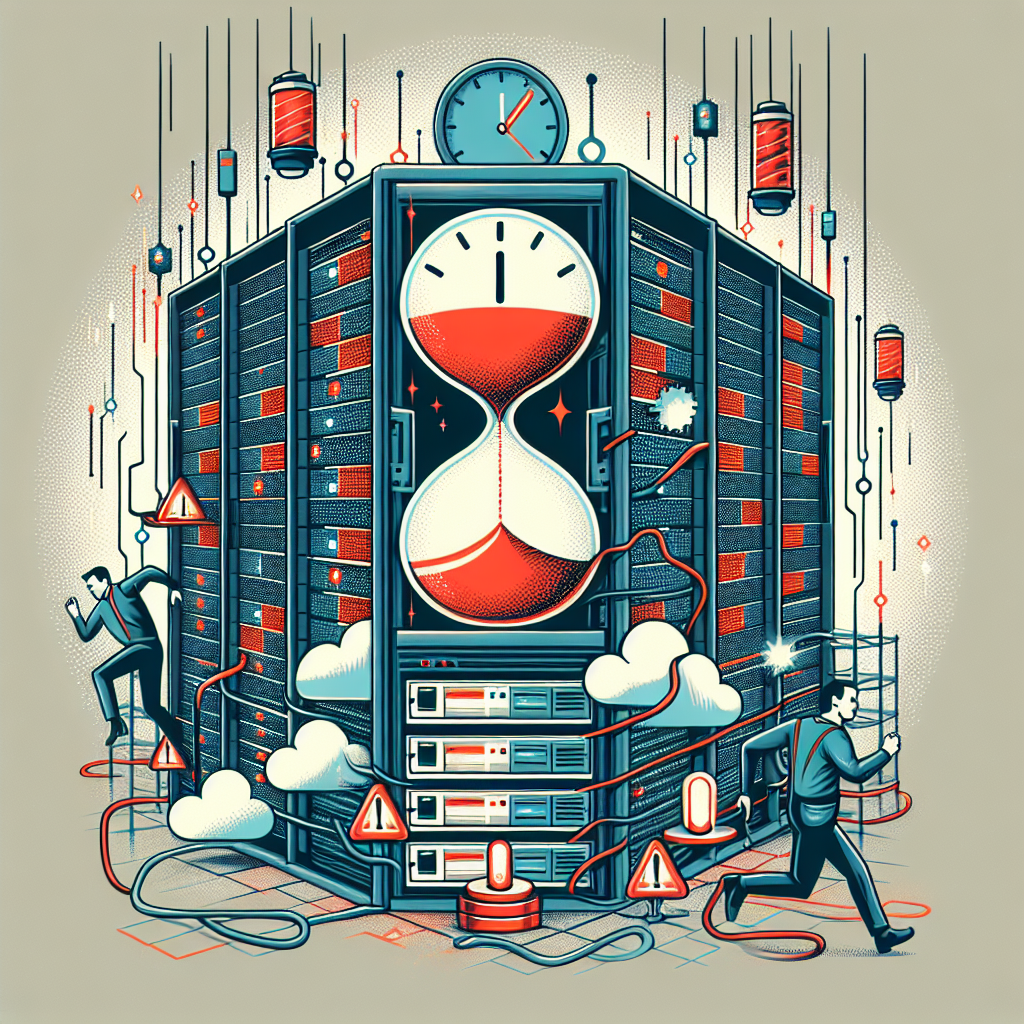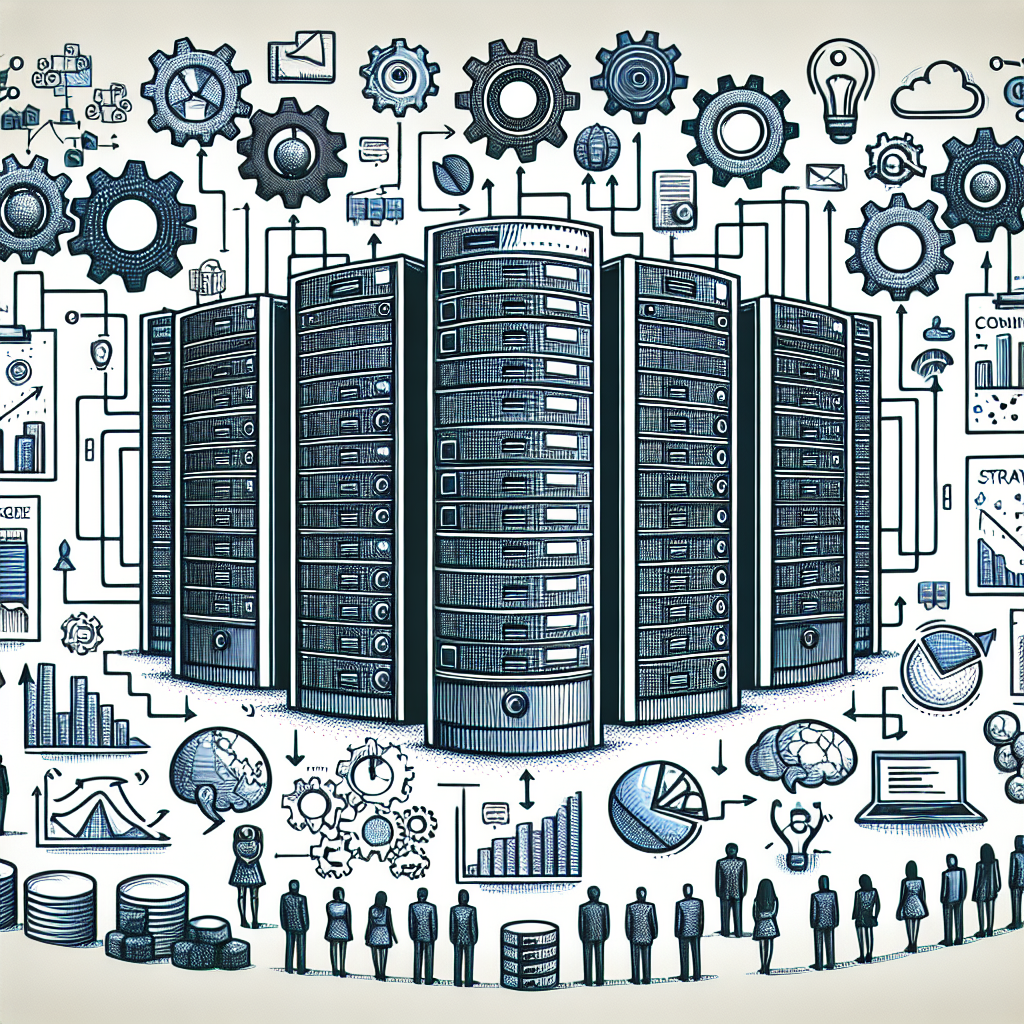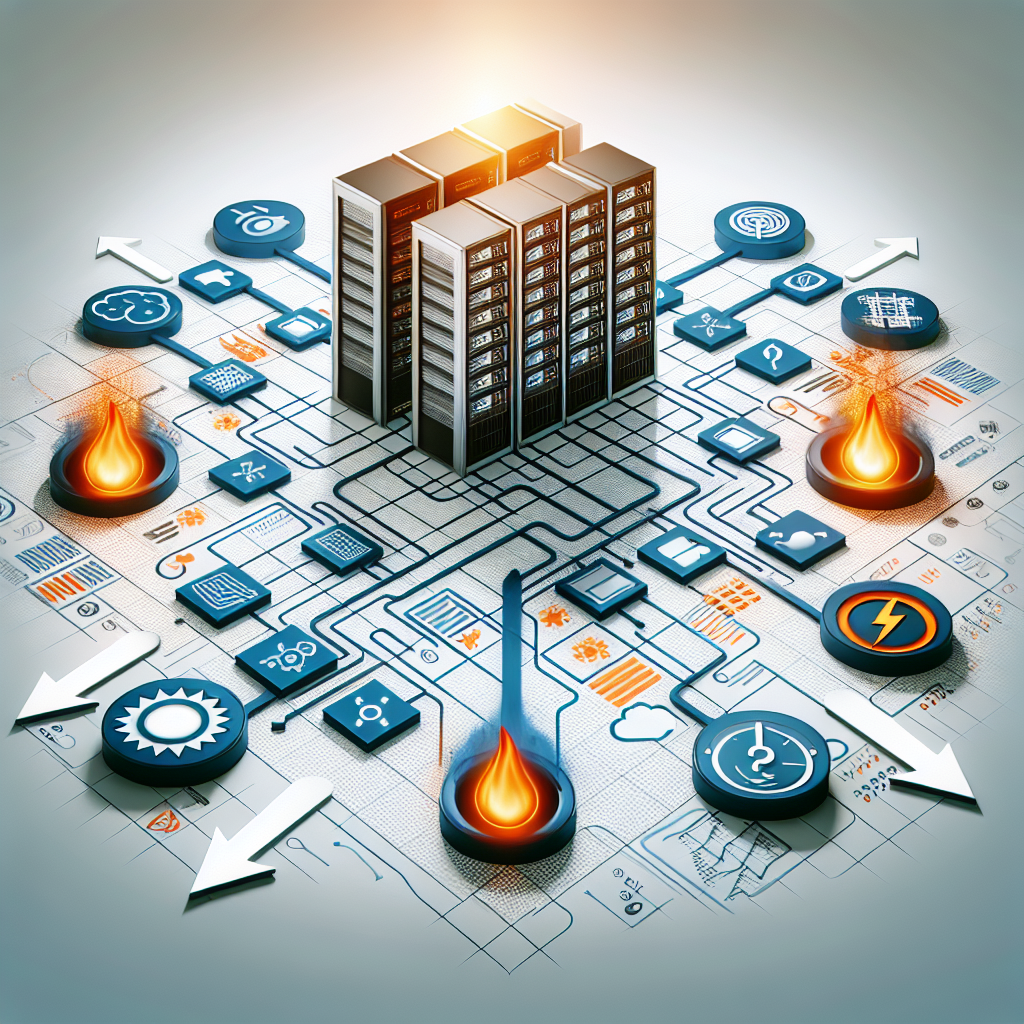Your cart is currently empty!
Tag: Resolving

Data Center MTTR: Why Time is of the Essence in Resolving Issues
In today’s fast-paced digital world, data centers play a crucial role in ensuring the smooth operation of businesses and organizations. These facilities house the servers, storage devices, networking equipment, and other critical infrastructure that support the day-to-day operations of an organization. As such, any downtime or service disruption can have a significant impact on the organization’s productivity, revenue, and reputation.One key metric that data center operators monitor closely is the Mean Time to Repair (MTTR), which measures the average time it takes to resolve an issue or incident in the data center. The MTTR is a critical indicator of the data center’s operational efficiency and its ability to quickly address and resolve issues that may arise.
Time is of the essence when it comes to resolving issues in a data center. The longer it takes to identify and address the root cause of an issue, the greater the impact on the organization’s operations. Downtime can result in lost revenue, decreased productivity, and damage to the organization’s reputation. As such, data center operators must prioritize reducing the MTTR and ensuring that issues are resolved as quickly and efficiently as possible.
There are several factors that can influence the MTTR in a data center. One of the key factors is the availability of skilled personnel who are trained to identify and address issues quickly. Having a team of experienced technicians who are well-versed in the data center’s infrastructure and systems can help reduce the time it takes to resolve issues.
Another factor that can impact the MTTR is the availability of monitoring and management tools that can help identify issues in real-time. These tools can provide data center operators with insights into the performance of the infrastructure, alert them to potential issues, and help them troubleshoot and resolve problems quickly.
In addition, having a well-defined incident response and escalation process can help streamline the resolution of issues in a data center. By establishing clear roles and responsibilities, defining escalation paths, and setting clear priorities, data center operators can ensure that issues are addressed promptly and efficiently.
In conclusion, data center MTTR is a critical metric that measures the time it takes to resolve issues in a data center. Time is of the essence when it comes to addressing issues in a data center, as downtime can have a significant impact on an organization’s operations. By prioritizing reducing the MTTR, investing in skilled personnel and monitoring tools, and establishing clear incident response processes, data center operators can ensure that issues are resolved quickly and efficiently, minimizing the impact on the organization.

Resolving Data Center Problems Quickly and Effectively: A Guide to Problem Management
In today’s fast-paced business environment, data centers play a crucial role in ensuring the smooth operation of an organization’s IT infrastructure. However, like any complex system, data centers are prone to problems that can disrupt operations and cause significant downtime. In order to minimize the impact of these issues, it is essential for organizations to have a comprehensive problem management strategy in place.Problem management is the process of identifying and resolving issues that affect the performance and availability of a data center. By proactively addressing problems before they escalate, organizations can minimize downtime, improve service levels, and enhance the overall efficiency of their IT operations.
To effectively resolve data center problems, organizations should follow these key steps:
1. Identification: The first step in problem management is to identify and categorize issues affecting the data center. This involves monitoring the performance of critical systems and applications, as well as analyzing incident reports and user feedback. By establishing a clear process for logging and tracking problems, organizations can quickly identify and prioritize issues that require immediate attention.
2. Root cause analysis: Once a problem has been identified, it is important to conduct a thorough root cause analysis to determine the underlying factors contributing to the issue. This may involve reviewing system logs, conducting interviews with stakeholders, and performing diagnostic tests to identify the source of the problem. By understanding the root cause of an issue, organizations can develop effective solutions to prevent recurrence in the future.
3. Resolution: After identifying the root cause of a problem, organizations should implement a solution to resolve the issue and restore normal operations. This may involve applying software patches, reconfiguring hardware, or implementing new processes to address the underlying cause of the problem. It is important to document the resolution process and communicate it to all relevant stakeholders to ensure a coordinated response.
4. Monitoring and feedback: Once a problem has been resolved, it is important to monitor the data center environment to ensure that the issue does not recur. This may involve conducting regular performance checks, implementing proactive monitoring tools, and soliciting feedback from users to identify any ongoing issues. By maintaining a proactive approach to monitoring, organizations can quickly identify and address emerging problems before they escalate.
5. Continuous improvement: Problem management is an ongoing process that requires continuous improvement to ensure the effectiveness of the strategy. By conducting regular reviews of incident reports, analyzing trends, and implementing lessons learned from past incidents, organizations can refine their problem management processes and enhance the overall resilience of their data center operations.
In conclusion, resolving data center problems quickly and effectively requires a proactive approach to problem management. By identifying issues early, conducting root cause analysis, implementing effective solutions, and continuously monitoring and improving processes, organizations can minimize downtime, enhance service levels, and ensure the smooth operation of their IT infrastructure. By following these key steps, organizations can effectively manage data center problems and maintain a high level of performance and availability in their IT operations.

Effective Methods for Resolving Data Center Downtime
Data center downtime can be a major headache for businesses, causing disruption to operations and potentially leading to significant financial losses. In today’s digital age, where businesses rely heavily on technology to function, it is imperative to have effective methods in place to resolve data center downtime as quickly and efficiently as possible.One of the most important steps in resolving data center downtime is to have a comprehensive and up-to-date disaster recovery plan in place. This plan should outline the necessary steps to take in the event of a data center outage, including who is responsible for what tasks, how to communicate with stakeholders, and what procedures to follow to bring the data center back online.
Regular maintenance and monitoring of data center equipment is also crucial in preventing downtime. By regularly checking for any potential issues or signs of wear and tear, businesses can address problems before they escalate into major outages. This includes monitoring temperature and humidity levels, checking for faulty hardware, and ensuring that backup systems are in place and functioning properly.
Having redundant systems in place is another effective method for resolving data center downtime. By having backup power supplies, cooling systems, and network connections, businesses can minimize the impact of any potential outages and ensure that critical operations can continue without interruption. Redundancy can also help to distribute the load across multiple systems, reducing the risk of any single point of failure bringing down the entire data center.
In the event of a data center outage, it is important to have a clear and well-defined incident response plan in place. This plan should outline the steps to take to troubleshoot the issue, communicate with stakeholders, and bring the data center back online as quickly as possible. Having a dedicated team of IT professionals who are trained to handle emergencies can help to streamline the response process and ensure that downtime is kept to a minimum.
Lastly, businesses should consider investing in remote monitoring and management tools to help proactively identify and address potential issues before they cause downtime. These tools can provide real-time alerts and notifications about any abnormalities in the data center environment, allowing IT teams to take immediate action to resolve the issue before it escalates.
In conclusion, data center downtime can have serious implications for businesses, but by implementing effective methods such as having a disaster recovery plan, regular maintenance and monitoring, redundant systems, incident response plans, and remote monitoring tools, businesses can minimize the impact of downtime and ensure that critical operations can continue without interruption. By being proactive and prepared, businesses can effectively resolve data center downtime and keep their operations running smoothly.

Best Practices for Data Center Problem Management: Tips and Techniques for Resolving Issues Efficiently
In today’s digital age, data centers play a crucial role in ensuring the smooth operation of businesses and organizations. These facilities house servers, storage systems, networking equipment, and other critical infrastructure that support the flow of data and information. However, like any complex system, data centers are prone to issues and problems that can disrupt operations and cause downtime.Effective problem management is essential for maintaining the reliability and performance of a data center. By promptly identifying and resolving issues, IT teams can minimize downtime, improve efficiency, and ensure business continuity. In this article, we will discuss some best practices for data center problem management, along with tips and techniques for resolving issues efficiently.
1. Establish a proactive monitoring system: One of the key elements of effective problem management is proactive monitoring. By continuously monitoring the performance of your data center infrastructure, you can quickly detect and address issues before they escalate into major problems. Implementing a robust monitoring system that tracks key performance indicators, such as server CPU usage, network bandwidth, and storage capacity, can help you stay ahead of potential issues and minimize downtime.
2. Create a centralized incident management system: To efficiently manage data center problems, it’s essential to have a centralized incident management system in place. This system should provide a single point of contact for reporting and tracking issues, as well as a structured process for prioritizing and resolving incidents. By centralizing incident management, IT teams can streamline communication, improve visibility, and ensure that issues are addressed in a timely manner.
3. Implement automated problem resolution tools: Automation can significantly improve the efficiency of data center problem management. By leveraging automation tools and scripts, IT teams can quickly diagnose and resolve common issues without manual intervention. For example, automated monitoring tools can automatically restart services or trigger alerts when certain thresholds are exceeded. By automating routine tasks, IT teams can focus on more strategic initiatives and reduce the risk of human error.
4. Conduct root cause analysis: When addressing data center problems, it’s important to not only resolve the immediate issue but also identify the underlying cause. Conducting root cause analysis can help prevent recurring issues and improve the overall stability of the data center. By investigating the root cause of problems, IT teams can implement corrective actions to address systemic issues and prevent future incidents.
5. Implement a continuous improvement process: Problem management is an ongoing process that requires continuous improvement. By regularly reviewing and analyzing incident data, IT teams can identify trends, patterns, and recurring issues that need to be addressed. Implementing a continuous improvement process allows data center teams to proactively address potential problems, optimize performance, and enhance the overall reliability of the infrastructure.
In conclusion, effective problem management is essential for maintaining the reliability and performance of a data center. By following best practices such as proactive monitoring, centralized incident management, automation, root cause analysis, and continuous improvement, IT teams can efficiently resolve issues and minimize downtime. By implementing these tips and techniques, organizations can ensure that their data center operations run smoothly and support the needs of the business.

Resolving Data Center Challenges: Strategies for Effective Problem Management
Data centers play a crucial role in modern businesses, serving as the backbone of IT infrastructure and housing mission-critical applications and data. However, managing a data center comes with its fair share of challenges, from hardware failures and power outages to security breaches and capacity limitations. In order to ensure the smooth operation of a data center and minimize downtime, it is essential to have effective problem management strategies in place.One of the key challenges faced by data center managers is hardware failures. These can occur unexpectedly and have a significant impact on the performance and availability of the data center. To address this challenge, data center managers should implement a proactive approach to monitoring and maintenance. Regularly monitoring the health and performance of hardware components, such as servers, storage devices, and network equipment, can help identify potential issues before they escalate into full-blown failures. Additionally, having spare hardware components on hand can help minimize downtime in the event of a failure.
Power outages are another common challenge faced by data centers, particularly in regions prone to extreme weather events or unreliable power grids. To mitigate the impact of power outages, data center managers should invest in uninterruptible power supply (UPS) systems and backup generators. These systems can provide temporary power to critical equipment during outages, allowing the data center to continue operating until normal power is restored. Regular testing of UPS systems and generators is essential to ensure they are functioning properly when needed.
Security breaches are a major concern for data center managers, as they can result in data loss, downtime, and reputational damage. To prevent security breaches, data center managers should implement robust security measures, such as firewalls, intrusion detection systems, and access controls. Regular security audits and penetration testing can help identify vulnerabilities and weaknesses in the data center’s security infrastructure, allowing for timely remediation. Additionally, employee training and awareness programs can help reduce the risk of insider threats and human errors.
Capacity limitations are another significant challenge for data center managers, especially as businesses continue to generate increasing amounts of data. To address capacity limitations, data center managers should regularly assess the data center’s capacity requirements and plan for future growth. This may involve upgrading existing hardware, expanding storage capacity, or leveraging cloud services to offload non-critical workloads. Implementing virtualization and containerization technologies can also help optimize resource utilization and improve scalability.
In conclusion, resolving data center challenges requires a proactive and strategic approach to problem management. By implementing effective monitoring and maintenance practices, investing in resilient infrastructure, strengthening security measures, and planning for future capacity needs, data center managers can ensure the smooth operation of their data centers and minimize the impact of potential issues. By addressing these challenges head-on, businesses can maintain the availability, performance, and security of their data center operations.

Effective Strategies for Resolving Data Center Network Problems
Data center network problems can be a major headache for IT professionals. These issues can lead to downtime, slow performance, and security vulnerabilities. However, with the right strategies in place, these problems can be resolved quickly and effectively. In this article, we will discuss some effective strategies for resolving data center network problems.1. Identify the root cause of the problem: Before you can effectively resolve a data center network issue, you need to identify the root cause of the problem. This may require conducting a thorough network audit to pinpoint where the issue is originating from. Common causes of network problems include hardware failures, configuration errors, and bandwidth limitations.
2. Monitor network performance: Monitoring network performance is crucial for identifying issues before they escalate into major problems. Utilize network monitoring tools to track metrics such as bandwidth usage, latency, and packet loss. By monitoring these key indicators, you can proactively address issues before they impact your network’s performance.
3. Implement redundancy and failover mechanisms: To minimize downtime and ensure high availability, it is essential to implement redundancy and failover mechanisms in your data center network. This can include redundant network links, backup power supplies, and failover protocols to automatically switch traffic to secondary paths in the event of a network failure.
4. Update and patch network equipment: Outdated firmware and software can leave your network vulnerable to security threats and performance issues. Regularly update and patch your network equipment to ensure that it is running the latest software versions and security patches. This will help to prevent network problems caused by known vulnerabilities.
5. Optimize network configuration: Poor network configuration can lead to bottlenecks, latency issues, and performance degradation. Take the time to optimize your network configuration by implementing best practices such as VLAN segmentation, Quality of Service (QoS) policies, and load balancing. By fine-tuning your network configuration, you can improve performance and reduce the likelihood of network problems.
6. Conduct regular network testing: Regularly testing your network can help to identify issues before they impact your operations. Perform network stress tests, bandwidth tests, and security audits to ensure that your network is performing optimally. This proactive approach can help you catch potential problems early and take corrective action before they escalate.
In conclusion, resolving data center network problems requires a combination of proactive monitoring, strategic planning, and effective troubleshooting. By following these strategies, you can minimize downtime, improve network performance, and ensure the reliability of your data center network. Remember that prevention is always better than cure when it comes to network problems, so investing time and resources in maintaining a healthy network infrastructure is key to avoiding costly disruptions in the future.

Resolving Data Center Power and Cooling Challenges: A Troubleshooting Guide
Data centers are the backbone of modern technology, housing servers, storage systems, and networking equipment that keep businesses running smoothly. However, with the increasing demands for computing power and the rise of high-density servers, data centers are facing new challenges when it comes to power and cooling.Power and cooling issues can lead to downtime, reduced performance, and increased costs for data center operators. In this troubleshooting guide, we will explore some common power and cooling challenges faced by data centers and provide tips on how to resolve them effectively.
1. Overheating: One of the most common issues in data centers is overheating. High-density servers generate a significant amount of heat, and if not properly cooled, this can lead to equipment failure and downtime. To resolve overheating issues, consider implementing a containment system to separate hot and cold air, installing additional cooling units, or optimizing airflow within the data center.
2. Power Outages: Power outages can be catastrophic for data centers, leading to data loss and downtime. To prevent power outages, consider investing in backup power systems such as uninterruptible power supplies (UPS) or generators. Regularly test these systems to ensure they are functioning properly in the event of a power failure.
3. Power Surges: Power surges can damage equipment and lead to data loss. To protect against power surges, install surge protectors or power conditioning units to regulate voltage fluctuations. Additionally, consider implementing redundant power supplies for critical equipment to ensure continuous operation.
4. Energy Efficiency: Data centers are notorious for their high energy consumption. To improve energy efficiency and reduce cooling costs, consider implementing energy-saving measures such as hot aisle/cold aisle containment, using energy-efficient cooling systems, and optimizing server configurations to reduce power consumption.
5. Capacity Planning: As data centers grow and expand, it is important to plan for future power and cooling requirements. Conduct regular capacity planning assessments to determine if the current infrastructure can support future growth. Consider upgrading cooling systems, adding additional power sources, or consolidating servers to optimize space and energy usage.
In conclusion, resolving power and cooling challenges in data centers requires a proactive approach and careful planning. By implementing the tips outlined in this troubleshooting guide, data center operators can ensure optimal performance, reduce downtime, and lower operating costs. Remember to regularly monitor and maintain power and cooling systems to ensure they are functioning efficiently and effectively.

Top Strategies for Resolving Data Center Performance Issues
Data centers are the backbone of modern businesses, serving as the hub for storing, processing, and managing vast amounts of data. However, even the most advanced data center infrastructure can encounter performance issues that can disrupt operations and impact productivity. To ensure optimal performance and prevent downtime, it is essential to implement effective strategies for resolving data center performance issues. Here are some top strategies to address common data center performance issues:1. Monitor and analyze performance metrics: One of the key steps in resolving data center performance issues is to monitor and analyze performance metrics regularly. By tracking key performance indicators such as server utilization, network traffic, and storage capacity, IT teams can identify potential bottlenecks and proactively address them before they escalate into critical issues.
2. Implement capacity planning: Data centers must have sufficient capacity to handle the increasing demands of data processing and storage. Implementing capacity planning practices can help organizations forecast future resource requirements and scale their infrastructure accordingly to prevent performance issues caused by resource constraints.
3. Optimize data center infrastructure: Improving the efficiency and performance of data center infrastructure components such as servers, storage devices, and networking equipment can significantly enhance overall data center performance. Regular maintenance, firmware updates, and hardware upgrades can help optimize the performance of these components and minimize the risk of performance issues.
4. Implement load balancing and virtualization: Load balancing and virtualization technologies can help distribute workloads evenly across servers and optimize resource utilization, thereby improving data center performance. By virtualizing servers and applications, organizations can achieve greater flexibility, scalability, and efficiency in managing their data center resources.
5. Enhance network performance: Network congestion and latency are common causes of data center performance issues. To address these issues, organizations can optimize network configurations, upgrade network infrastructure, and implement quality of service (QoS) policies to prioritize critical traffic and ensure reliable network performance.
6. Implement disaster recovery and data backup solutions: Data center performance issues can be exacerbated by data loss or system failures. Implementing robust disaster recovery and data backup solutions can help organizations minimize downtime and data loss in the event of a disaster or system failure, ensuring business continuity and data integrity.
7. Collaborate with vendors and industry experts: In some cases, resolving complex data center performance issues may require expertise beyond the capabilities of internal IT teams. Collaborating with vendors, industry experts, and consulting firms can provide valuable insights and best practices for optimizing data center performance and resolving critical issues effectively.
By implementing these top strategies for resolving data center performance issues, organizations can enhance the reliability, efficiency, and scalability of their data center infrastructure. Proactive monitoring, capacity planning, infrastructure optimization, and collaboration with industry experts can help organizations mitigate performance issues and ensure seamless operations in their data centers.


